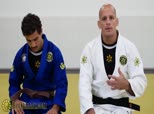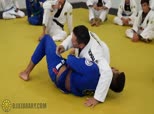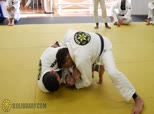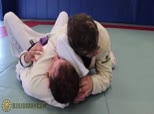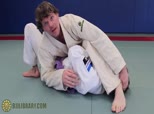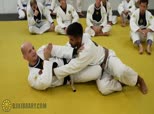Xande's Dominant Control Series 1 - Introduction
Add to Favorites Remove From Favorites 984 2044 days ago
In this series, Xande covers how to maintain control in dominant attacking positions, and work to your ultimate goal which is to finish your opponent. It's very common nowadays, especially in competition, that Jiu Jitsu practitioners establish a dominant position and then lose it after they are awarded their points. In the following videos, Xande will breakdown why this happens, how to avoid it and what you should be focusing on when controlling your opponent.
Inside the University 537 - Framing Before Recovering
Add to Favorites 847 Remove From Favorites 2090 days ago
Now Saulo focuses on the importance of recovering guard with two specific movements after turning on his side. When he brings his knee in the first time, this is to set his frame. He is not yet looking to recover because he doesn't have the space. Next he escapes his hips, and now he has the space to bring his knee in more and begin to recover.Inside the University 535 - Recovering Guard when Your Opponent Passes Your Legs
Add to Favorites 905 Remove From Favorites 2092 days ago
Saulo's opponent is passing his guard, so as soon as he gets around the legs, Saulo's first move is to turn on his side at his 45 degree angle, with both elbows attached to his body. His opponent drops his weight to put pressure, so Saulo bridges to create space. If he now has room to move his hips, he brings his legs in to recover guard.Inside the University 521 - Isolating the Arm
Add to Favorites 712 Remove From Favorites 2109 days ago
Now Gustavo fine tunes some of the details of trapping the arm. He also shows how he can set up the same armbar from other guard passes. The main point of focus is to use his elbow to pin and isolate the arm he wants as soon as his opponent turns away.Inside the University 520 - Armbar from Side Control when Opponent Tries to Turn Away
Add to Favorites 750 Remove From Favorites 2110 days ago
After Gustavo passes to the side, his opponent tries to turn away to escape, exposing his back. Gustavo controls the head with one arm and his other arm traps his opponent's arm to his body. After stopping his opponent from rolling, Gustavo brings his shin along the back, sitting in the S-position. From here he can use his elbow to pinch the arm, and he falls back, throwing his other leg over the head to finish the armbar.Dennis Hallman Series 7 - Arm Lock from Arm Triangle
Add to Favorites 568 Remove From Favorites 2127 days ago
Dennis is trying to finish an arm triangle choke, but his opponent is defending by putting his hand to his ear as if he's talking on the phone. Dennis grabs the wrist with his outside hand and feeds it to his inside hand. Next he holds the wrist with both hands and puts his head at the elbow to act as a fulcrum. Now he uses his outside hand to pull the wrist away, finishing a sort of key lock.Dennis Hallman Series 6 - Howdy Neck Crank
Add to Favorites 565 Remove From Favorites 2128 days ago
Again Dennis steps over the head, and his opponent pushes the leg so he sets up his head lock trapping the arm with his body. Rather than turn away, this time his opponent tries to turn into him. Dennis now hops to the other side of the body and lifts the head as he squeezes, finishing a painful neck crank.Dennis Hallman Series 4 - Howdy Figure Four Lock
Add to Favorites 553 Remove From Favorites 2130 days ago
This time when Dennis steps over the head, his opponent doesn't do anything, so he grabs the back of the head and makes a figure four lock with his legs. From here, he has several options, including arm locks, toe holds, or if it's MMA, he can throw body punches.Dennis Hallman Series 3 - Howdy Americana
Add to Favorites 278 Remove From Favorites 2132 days ago
Continuing the Howdy series, when Dennis steps over the head, his opponent reacts by pushing his face. Now Dennis grabs the wrist and sets up his key lock grip, and jumps up to put his knee on his opponent's face. To finish the Americana, he pulls the to him and cranks the key lock.Dennis Hallman Series 2 - The Howdy Choke
Add to Favorites 771 Remove From Favorites 2135 days ago
The first series of techniques Dennis shows is called the Howdy Series, and each position begins from side control with his hips facing the head. In this scenario, his opponent is keeping his elbow on the mat, so Dennis steps his leg over the head, causing his opponent to push the leg off. This opens up his side, and Dennis reaches across the body, swims his arm under the head, traps his opponent's arm with his body, and grabs his own biceps to lock in a tight head and arm choke.Inside the University 501 - Sweeping the Floor with Your Feet
Add to Favorites 843 Remove From Favorites 2165 days ago
One detail Xande points out here is that it is not good to stomp your feet on the mat to gain leverage for your bumps when you want to escape. Instead, he is just sweeping the mat as he takes small steps away from his opponent. This allows him to stay connected to the mat, ready to react whenever necessary, and also does not telegraph his next move to his opponent. Now he works his side control escape drill with this in mind, and focuses on keeping a connection with the mat.Inside the University 500 - Setting Up the Hip Bump
Add to Favorites 862 Remove From Favorites 2166 days ago
Touching on a common mistake, Xande points out how he does not like to make a big hip bump right away. Instead, he moves a little to makes some space, makes sure his frames are in place and then makes his big hip bump and extends his body. Sometimes he even waits for a reaction from his opponent to time his bump. Also, he makes sure to keep his frames in place until he has recovered his guard.
